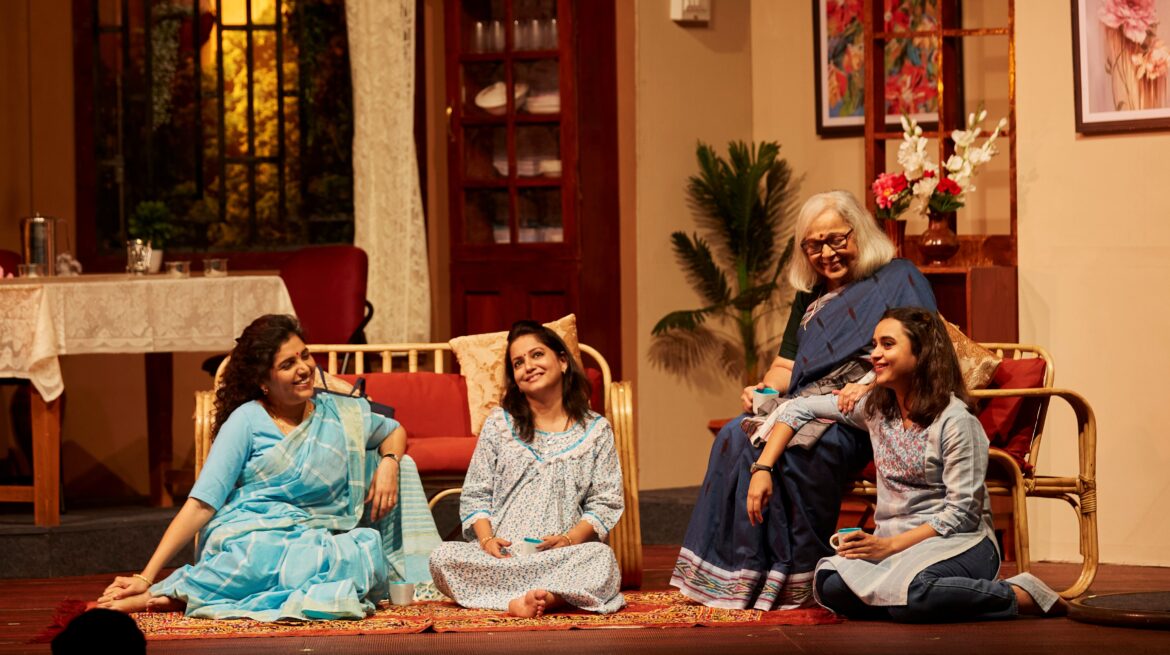The Fab Four:
In 1990, Prashant Dalvi’s Marathi play, Charchaughi, directed by Chandrakant Kulkarni, was first staged. It may be a broad generalisation, but subjects in modern Marathi theatre have been more progressive in their attitude towards women, but even so, this play was considered revolutionary for the times and has become a landmark. The four female parts were played by actresses, who went on to become stars and stage legends—Deepa Shreeram, Vandana Gupte, Asawari Joshi, Pratiksha Lonkar.
It was about a woman who has three daughters out of wedlock; the father is a presence in their lives, but stays on with his first and legal family. The mother’s decision to defy society impacts the lives of the daughters in good ways and bad. They grow up to be independent, but their relationships get complicated. Back then, it must have been difficult if not unthinkable for a woman to take such a step, and get away without ugly social repercussions. Divorce was difficult and frowned upon so severely, that women were trapped in bad marriages for want of a better option.
The new production, which had crossed 225 shows in about a year, has equally high-powered cast comprising Rohini Hattangady, Mukta Barve, Kadambari Kadam and Parna Pethe, does not update the period—so though Aai’s Pune apartment is well-appointed, there are obviously no cell phones and computers. There is a landline with an extension, significant because a powerful monologue delivered in the form of a phone call between a wife and her estranged husband, interrupted by Aai on the extension.
Today, single women are heads of the family, but having kids without a husband in the picture is still not so common. The oldest daughter, Vidya, discovers that her husband is having an affair and leaves her marital home to return to her mother’s, where she is welcomed without question. She cares about and misses her daughter immensely, but does something unusual—she demands shared custody for the child, six months with her and six with the father. Today, joint custody is routinely granted, but three decades ago, the judge disapproves of a mother not wanting to take full custody of her child, the implication being that she is already looking for a new husband; the man who is responsible for breaking up a marriage due to his infidelity, gets away without any social or legal censure. Thankfully, now at least in the big cities, divorce is not so skewed against the woman.
The second daughter, Vaiju, is exasperated because her husband cannot hold down a job; she is tired being the sole breadwinner as well as looking after the home, while the husband makes his grand schemes, which never amount to anything. To top it all, he demands that she have a child, more as a mark of his manhood than any great desire to be a father. Vaiju’s problem and her solution of reluctant compromise is the path taken by most women.
The youngest daughter, Vini, affected by the unstable relationships around her, cannot make up her mind between two of her close male friends—one a serious academic sort, and the other wealthy and fun-loving. She comes up with the idea of living with both of them, which was unlikely to be accepted 30 years ago, and a tough sell even now. Living in with a partner is no longer taboo, but even in a we-mind-our-business city like Mumbai, a young woman and two men would probably find it difficult to rent a flat.
The playwright thought up scenarios and characters 30 years ago which seem more plausible now, but are still not considered normal even in contemporary urban society. Still, Kulkarni’s empathetic direction leads audiences to relate to them, and there are audible ‘hmmms’ in the theatre whenever a line about inequality or injustice is spoken. In spite of the heavy-duty emotional complexities, Charchaughi is not a depressing play—there is humour, courage, hope conveyed through the text and performances. The takeaway from the play is that if a woman refuses to bow to convention, nobody can break her. Charchaughi was way ahead of its time when it was originally staged, and society is starting to catch up, but there’s a long way to go for unconditional gender equality.
(This a modified version of the piece that appeared in The Free Press Journal dated September 22, 2023)

